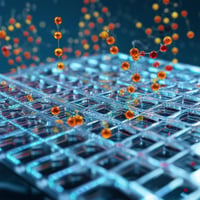In the rapidly evolving landscape of single cell RNA sequencing, researchers still face...
Towards Virtual Tissue Models: A Conversation with Dr. Barbara Treutlein on Organoids, AI, and High-Throughput Single Cell Screening
At the forefront of cell biology and tissue engineering, Dr. Barbara Treutlein is pioneering ways to understand and model the human brain. As a professor at ETH Zurich and winner of the 100 Million Cell Challenge, alongside collaborator Dr. Fabian Theis, she's combining innovative approaches to study brain development underlying mechanisms of disease with single cell analysis. In this insightful conversation, Dr. Treutlein shares her excitement of using organoids to model the human brain, harnessing AI to accelerate laboratory discoveries, and how massive-scale single-cell experiments are bringing us closer to complete virtual models of human tissues.
Q: To start off, would you tell us a bit about your research?
Barbara Treutlein: We use single cell genomic technologies to understand human organ development. We focus on brain and to model human brain development, we use stem cell derived organoids. These are three-dimensional tissues grown in vitro that really mimic the architecture of human brain tissue, but also functional aspects of the human brain. They are exciting systems because we can grow them at scale. We can grow many tissues for an individual. We can grow them from different individuals from whom we have iPS cells. And then we can also genetically and environmentally perturb them. That's why we are particularly interested in them.
We use the single cell data from these organoids to learn how cells adopt their fate, which genes and gene regulatory programs are underlying cell fate specification, and how perturbations lead to disease.
Q: Would you tell us a little bit about the project you're going to be running on QuantumScale?
BT: Organoids are a relatively new model. In the past few years we have tried to move them into really high throughput perturbation screens. So far we have been perturbing 20-30 genes at a time genetically, or using drugs. But we are ready to increase the scale because we have established automated organoid culture and automated dissociation of organoids to actually do screens at higher throughput. Our project relies on a high throughput pathway perturbation screen in human organoids. We are focusing on all major regions of the brain from forebrain to midbrain to hind brain. The idea is to perturb a large number of signal transduction pathways with drugs and also perform a lot of combinatorial perturbations. The final goal is then to take all this data and train AI based models that will eventually be able to predict unseen perturbations. Potentially AI could also guide future perturbation screens telling us which conditions to test, which ones are maybe the most powerful or promising.
"Overall, this gives us a much more detailed view on the dynamics of cells that we could not capture previously with snapshot data coarsely sampled over time. So for anything like that, you just need the capability of going to a larger scale and, and measuring more samples. I think it's super exciting that the field has opened up to these opportunities. "
Q: So it sounds like you're not focusing on any one disease, but kind of like a universal model so that if you know what a disease is perturbing or for a given mutation, you can predict what the effect is.?
BT: We try to be as broad as possible, targeting all major pathways underlying the function of, in principle, any cell type, and then explore how these pathways are active in human brain cells and what's the crosstalk between pathways.
I think it's really an exciting time where we have the human models and can grow them at scale to actually run such perturbation screens in a relevant human context. We cannot use primary human brain tissue for this, and two-dimensional cultures of human cells are not mimicking the in vivo complexity. Organoids in contrast have a very large diversity of cell types that we can perturb together.
We can ask “what is the response of a given cell type?” and why do different cell types react differentially. The AI model can learn all this and in the future make predictions.
Q: So when you say scale up organoid production, how many organoids are you talking about at once?
BT: We are growing multiple thousands of organoids.
Q: Wow. So how do you think about the trade-off of including more organoids versus more cells, or more perturbations?
BT: We have been discussing a lot about that. We are now scaling up the number of perturbations by a factor of 10 compared to what we were previously doing. This includes individual perturbations but also combinations, which we haven't done before. The combinatorial space is huge, so we will not fully exhaust the combinatorial space. This is why we are excited to actually train models leaving out combinations we actually measured and then seeing whether we can predict them. I think we are still exploring what's a good number of perturbations, number of cells, number of tissues to profile to be able to do predictive modelling.
We are aiming for 2000- 3000 cells per sample, but this is driven by the cellular diversity of our organoids. Depending on how many cell types you find in a tissue, you may need more or less cells so you can profile a sufficient number of cells per cell type and per perturbation. Since organoids are heterogeneous, we need to make sure to have in this case several thousands of cells per organoid and then replicates to also take into account and be able to control for technical batch effects.
Q: That’s interesting. When you talk to researchers doing cell line screening, they're like, ‘Oh, we just want a few hundred cells, we don’t need a lot of cells.’
BT: Yeah, it's very different actually. Sometimes these screens are in, let’s say, three cancer cell lines. Every one of these lines are very homogeneous possibly containing just one cell type, so it's a whole different problem. In that case, you can use 100 cells per sample. With our organoids, we are talking about complex human tissue that really has a large number of different neuronal cell populations, glial cell populations and other cell types. To me, that makes it exciting because we are going beyond cell lines that don't truly mimic human physiology.
Q: Thinking longer term, what potential applications or discoveries do you think might emerge from this work?.’
BT: The big goal is really to learn the full phenotypic landscape of all human cell types. What is the landscape of cell states in a human body and what gene regulatory mechanisms, and also what kind of environmental cues move a cell from one to another state. Organoids are a really good in vitro model of human organs that allow you to probe this landscape.
Eventually, if you put all this data into a big foundation model, the hope is you can predict how any perturbation would change a cell’s phenotype, which cell types are most affected, and what are the off-targets effects of a drug that you didn't consider. Ultimately, we’re moving towards the huge goal of a virtual model of human tissues. But we need to generate these perturbation atlas data sets in order to move towards that.
Q: Will there be a day where you don't actually have to do an experiment in the lab? You can just probe the AI model? [laughs]’
BT: We might be putting ourselves out of jobs eventually, but there are still many things to do. We are fine tuning the choice of drugs, and even there we are trying to go at it in a data-driven way - we have gene regulatory networks inferred from single-cell multiomic experiments, which allow us to do in silico perturbations to prioritize perturbations, and choose actually those where we think the effects might be the largest. And of course, once you train a model, this model can also further predict which future experiments you should do. I envision that these models would help us more and more decide what to actually measure in the lab. Right now there are lots of drugs you can test in principle, but which ones do you choose and which combinations? I would be happy if AI would help me make these choices to perform the most informative experiment.
Q: The ecosystem of single cell technologies is starting to really take off and hopefully make it easier to do larger scale screening. I was wondering how you think that will impact your field? Why is it important to do these large-scale single cell experiments?
BT: Well, in our particular case, we are hoping to really move towards causality. We can finally start to explore the vast space of possible genetic and environmental perturbations that any cell in our body is exposed to and measure the response to these perturbations. And we can do this for heterogeneous tissues with many different cell types, even if some cell types are very rare. Performing large-scale single cell experiments allows you to capture even rare cell types. Also, we can strongly increase the number of time points that can be measured across cell trajectories to learn more about the differentiation of cells during development or the response of a cell to a perturbation. Overall, this gives us a much more detailed view on the dynamics of cells that we could not capture previously with snapshot data coarsely sampled over time. So for anything like that, you just need the capability of going to a larger scale and, and measuring more samples. I think it's super exciting that the field has opened up to these opportunities.
Through ambitious high-throughput single cell screening and computational modelling, Dr. Treutlein, Dr. Theis, and their teams are working toward a future where we can better understand human brain development and disease. While complete virtual models of human tissues may still be on the horizon, innovations in organoid generation, single cell technology, and AI modeling are already transforming our ability to study human biology at an unprecedented resolution and scale. Learn more about the 100M Cell Challenge and the other winners.





